Falklands War: Digging for physical memories on Mt Tumbledown
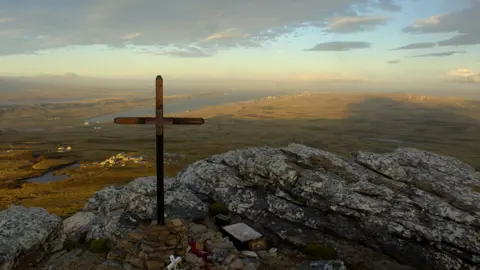 Getty Images
Getty ImagesArchaeologists and veterans have been surveying what remains in the battlefields of the Falkland Islands.
The unique project is documenting a number of Argentine defensive positions in the 1982 war, in particular for the decisive encounter on Mount Tumbledown.
The team has mapped rock-built fortifications, firing trenches, and mortar and artillery craters.
They have also recovered personal items and equipment to try to understand better what happened in the conflict.
These objects include cooking stands made from fencing wire, cut up oil drums for metal sheeting to construct shelters, bullets and bomb fragments.
Pairs of civilian shoes were found tucked neatly in rock crevices in some of the Argentines' temporary fortifications, or sangars.
This footwear was "wholly inappropriate" for the Falklands weather and terrain but had been "carefully" placed there for safe keeping, said project co-director and Oxford University archaeologist Dr Tim Clack.
 Beth Timmins
Beth TimminsStudying the memories of veterans alongside historical sources and the archaeological remains would enable a unique and "enhanced understanding of events", he explained.
The project is a joint enterprise between Oxford University, Glasgow University, the veteran well-being charity Waterloo Uncovered and the Falkland Islands Museum and National Trust.
Islanders have also got involved, as have British army veterans and even an artist.
In addition to getting archaeological results, the whole project has been designed to help veterans with post-traumatic stress disorder (PTSD) to come to terms with their experiences.
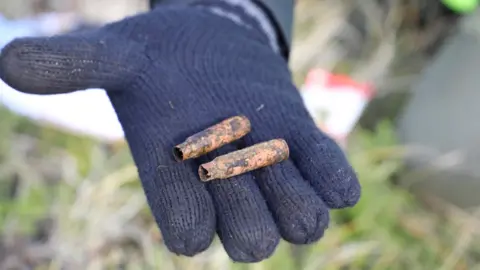 FWMP
FWMP 'Abundance' of finds
Mount Tumbledown was where the war ended. When British troops eventually captured the heights above Port Stanley in fighting across 13 and 14 June, the Argentine occupying force promptly surrendered.
But for the two-and-a-half months previous to this final engagement, the high ground in front of the capital was where the Argentines had dug in - in what were cold, dark, windy and snowy conditions.
The archaeological team found an "abundance" of scavenged metal, including fence wire and railway track, sleeping bags, blankets and entrenching tools that spoke to the "makeshift inhabitation" and "anticipation of the fighting to come", said Dr Clack.
 FWMP
FWMPThe researcher said the first-of-its-kind survey proved the positions taken up by the Argentine 5th Marine Battalion were more extensive than historical sources had indicated.
The number and variety of features had been a surprise, he added, and the survey had made it clear that events on other battlefields towards the end of the war, such as on Mount Longdon, had an effect on the Argentine defence of Tumbledown.
"There is still a lot of material out there, and if its location is recorded, it still has stories to tell," commented project co-director Prof Tony Pollard from Glasgow.
The archaeological evidence painted a "vivid picture", enabling the team "not just to map these remains within the landscape but also to plot the footsteps of those who fought across that incredibly rugged terrain", he continued.
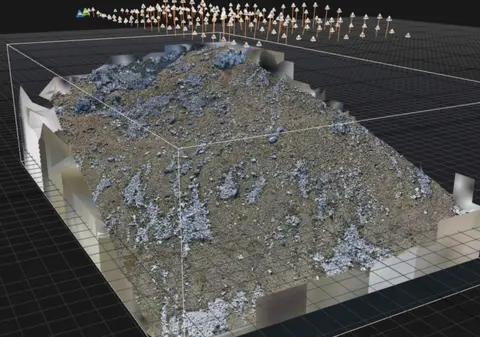 FWMP
FWMP3D archaeology
The team undertook a detailed drone survey of a number of areas of the battlefield to quickly and accurately record what currently survives in the field.
Three dimensional digital models are being made of a number of structures, such as bunkers and sangars.
This, archaeologist Dr Stuart Eve said, would make it possible to "simulate the different fields of fire", and to record the conditions combatants faced during the course of the campaign.
"The models and the surveyed data also act as a digital archive of the condition of the battlefield and the remains, before they deteriorate and are lost forever," Dr Eve said.
Forty years of exposure to the Falklands' harsh climate takes its toll. Grazing livestock doesn't help, either.
The team also found evidence of illegally excavated Argentine bunkers.
"Alas, we will likely never know what was found and taken by those that took it upon themselves to dig on the battlefield without permissions," Dr Clack added.
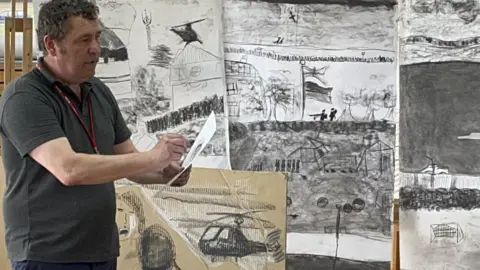 FWMP
FWMP Helping Veterans
The project is the first time that war veterans have taken part in an archaeological survey of their own battlefield.
For John, one of the two former Scots Guards involved, it marked his first visit to the Falklands since fighting in the battle for Tumbledown.
"It has been the trip of a lifetime to be part of the project and facing a few demons; it has been a life-changer," he explained.
"It's been emotionally very hard and enjoyable and a pleasure all at the same time - just like the four seasons in one day of weather in the Falklands."
Jim, who served alongside John, had visited the islands four times prior to the fieldwork. He said the project had helped him "get through the journey without too many hiccups".
The project "opened my eyes to a whole bigger picture of what happened in all areas of Tumbledown during battle," he added.
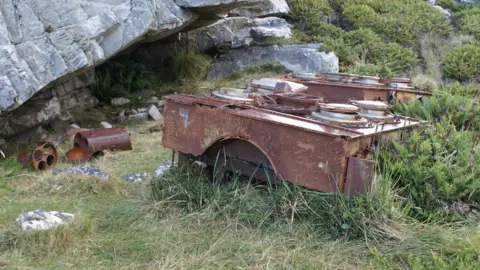 FWMP
FWMPLieutenant-Colonel (Retired) Rod Eldridge from Waterloo Uncovered assisted the project in his capacity as a mental health professional and said the archaeological work helped support the veterans' "new and updated appraisals of what happened during the battle for Tumbledown". This, Mr Eldridge said, brought "new, helpful and cathartic thoughts and feelings".
"The long-term exposure to their feared stimulus, the battle, during the trip reduced levels of anxiety.
"Meeting the Falkland Islanders who are so grateful for their sacrifice meant that their war had not been forgotten."
The insights the veterans provided, Prof Pollard said, created a "unique intersection" of physical remains, landscape and memory which "brought the past into the present".
"Having someone beside me who was actually there, and able to tell me, among many other things, that a cylinder of rubber, no bigger than the end of a pen, was the connector between a Milan missile and its guide wire was another experience entirely," Prof Pollard explained.
 Douglas Farthing
Douglas Farthing Museum sessions
Teaching sessions combining archaeology and art in the community's museum and schools were also led by the project's artist - Sergeant-Major (Retired) Douglas Farthing MBE.
Painting from the landscape, working with the team and local people created a "powerful" connection, he said.
Emma Goss, heritage conservation officer at the Falkland Islands Museum, also said the project was unique in both using the perspectives of former combatants and "in the future, utilising the first-hand perspectives of islanders who were heavily involved in the war".
"All of this adds a richness to field archaeology - which is not seen often," she added.
"The servicemen and women who defended these freedoms should feel proud for what I see today: happy smiling faces of children, a growing economy, conservation of wildlife and a protected landscape," Mr Farthing said.
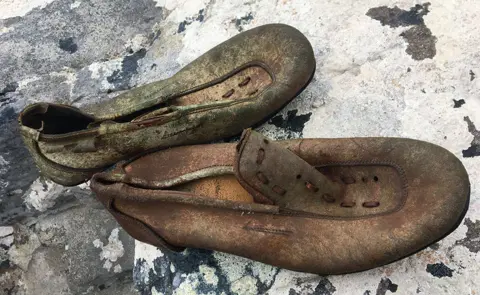 Beth Timmins
Beth Timmins